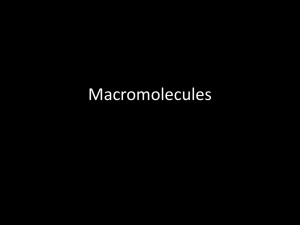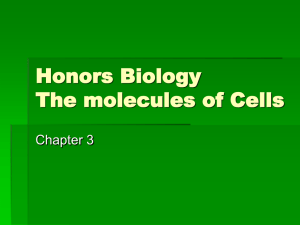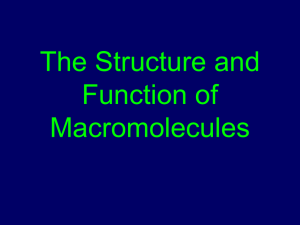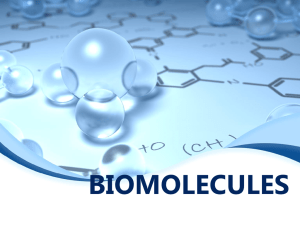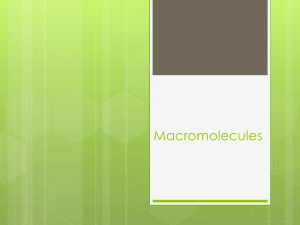Biomolecules
advertisement
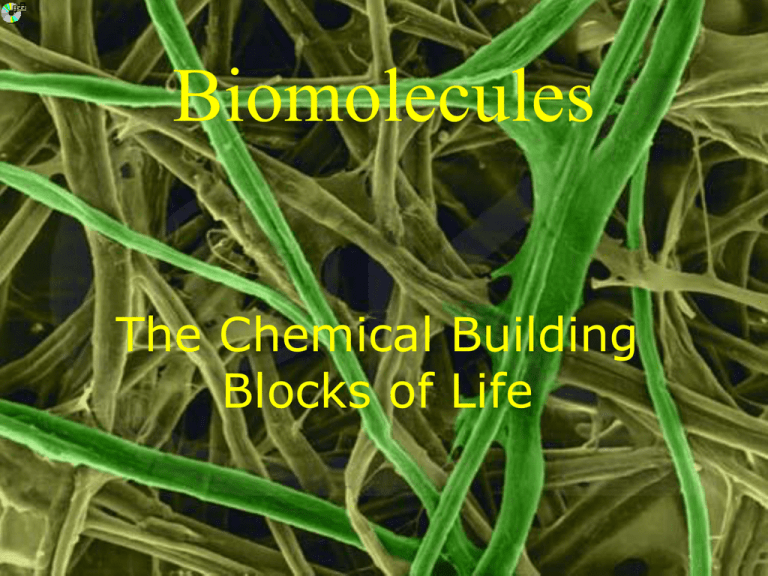
Biomolecules The Chemical Building Blocks of Life The Chemistry of Carbon • Organic molecules contain carbon • Carbon’s four valence electrons allow it to form up to four covalent bonds • Hydrocarbons consist only of C and H – Propane CH8 • It can easily bond to itself and form long chains – Linear - Cyclic - Branched Functional Groups • Chemical properties and reactivity are a result of functional groups • Functional groups maintain chemical properties no matter where they occur • Polar molecules are hydrophilic • Nonpolar molecules are hydrophobic • The degree to which organic molecules interact with water affects their function • Hydroxyl group (-OH) is one of the most common functional groups, it will make a molecule water soluble The Molecular Logic of Life Small molecules, common to all organisms, are arranged into unique macromolecules (Campbell p. 62) Macromolecules – The Sum of the Parts Many complex biological activities require large macromolecules Macromolecules are polymers poly: “many” mer: “units” ex: proteins, nucleic acids, starches Polymers are built by covalently linking together small similar (or in some cases, identical) subunits/building blocks called monomers mono: “one” mer: “unit” ex: amino acids, nucleotides, monosaccharides 4 Classes of Organic Compounds, or “Biomolecules”- necessary for an organism to survive: Proteins are polymers of amino acids Nucleic acids are polymers of nucleotides Starches are polymers of simple sugars called monosaccharides Lipids aren’t REALLY polymers, since they don’t have repeating chains. BUT they are important biomolecules. The building blocks (monomers) of some types of lipids are glycerol and fatty acids Condensation It’s not just for the water cycle anymore! This is how we link monomers together to create polymers • Macromolecules are constructed by covalently bonding monomers by condensation reactions where water is removed from the functional groups of the monomers • Dehydration synthesis (water is removed) • A hydroxyl (-OH) from one monomer and a hydrogen (-H) from another are removed • Anabolic reaction- requires energy Hydrolysis • Hydrolysis is the reverse of condensation • Results in the break down of polymers • Hydration reactions add water and break bonds, releasing energy-- catabolic animation Macromolecules- why are they so important? • Each macromolecule performs complex tasks with precision • The basic structure and function of each class of macromolecules is similar in all organisms (from the simplest bacteria to complex humans)– indicates an evolutionary link. Classes of Biomolecules • Carbohydrates •Lipids •Proteins •Nucleic Acids Basic Function Carbo’s Lipids N. Acids Energy Storage Structure Strength Long term storage Insulation Protection Hormones Sugars Fats DNA Oils/Waxes RNA Phospholipids ATP Steroid hormones (glucose) Starch/ Glycogen Cellulose/ Chitin Inheritance Blueprint for metabolism Proteins Catalysts Hormones Structure Defense Proteins Enzymes Carbohydrates How Sweet It Is! • General formula (CH2O)n • Simple sugars or large molecules made of sugar monomers • Monosaccharides (monomer) are covalently linked by condensation reaction to form polysaccharides (polymers) Sugars • Monosaccharides – Five carbon: Ribose – Six carbon: glucose and fructose •Disaccharides –Sucrose –Lactose •Polysaccharides –Starch –Glycogen –Chitin –Cellulose Polysaccharides Two Types for Storage 1. Glycogen – animal energy storage product that accumulates in the liver/muscles - Highly branched GlucoseGlycogenglucosebloodstream 2. Starch – plant energy storage - Helical - Easily digested by animals through hydrolysis Two Types for Structure: 1. Cellulose Polysaccharide found in plant cell walls • For humans cellulose is indigestible and forms dietary fiber • Made up entirely of β glucoses – Structure is constrained into straight microfibrils • Not an energy source for animals 2. Chitin – insect exoskeletons So what’s the difference between condensation and hydration reactions? • animation Lipids Functions: 1. Long-term energy storage/insulation (fats) 2. Structural components of cells (phospholipids) 3. Cellular messengers (hormones) More FAT • Triglycerides are composed of three fatty acids covalently bonded to one glycerol molecule •Fatty acids are composed of CH2 units and are hydrophobic- contain tons of energy in their hydrocarbons! •Fatty acids can be saturated (all single bonds) or unsaturated (one or more double bonds) •A fat (mostly saturated) is solid at room temp., while an oil (mostly unsaturated) is liquid at room temp. •Glycerol is a molecule with three carbons in a row, each with a hydroxide group •Fatty acid chains are hydrocarbons • that is, they are composed of mostly carbons and hydrogens. • This is a molecule that is VERY hydrophobic. •When glycerol combines with the fatty acid chains it forms a carboxyl group between them •They link by the loss of a water molecule. animation video Carbon can bond to four different substances, but sometimes it will share more than one pair of electrons. Phospholipids • Important structural component of cell membranes • Phosphate group (head) is polar and water soluble (hydrophilic) • Two fatty acid tails are hydrophobic •This allows the phospholipids to form bilayers and membranes • Steroids Other Lipids – Insoluble in water – Built around a four ringed skeleton • Cholesterol – Component for animal cell membranes – Formation of myelin sheath covering nerves • Hormones – Chemical messengers • Waxes – Many fatty acids linked to a long backbone – Waterproofing in plants, ears, beehives overview Proteins • 50% dry weight of body • Mammal cell contains 10,000 proteins • Enzymes (regulate chemical reactions) • Structural elements (cell membrane, muscles, ligaments, hair, fingernails) • Carriers (regulate what goes into/out of cells) • Send and receive messages (hormones) • Movement Building Blocks of Proteins Amino Acids • Amino acids (monomers) are linked together to form proteins (polymers) – Each unique sequence of amino acids forms a different protein – All living things (even viruses) use the same 20 amino acids • 20 different Amino Acids – – – – Amino end (NH2) Carboxyl end (COOH) Hydrogen R group – variable component Amino Acids • Amino Acids are grouped by whether R- group is polar or nonpolar •Positively charged side chain •Negatively charged side chains •Polar but uncharged side chains •Hydrophobic side chains •Special cases Protein Assembly • AA’s are linked together by joining the amino end of one molecule to the carboxyl end of another •Peptide bond forms a chain called a polypeptide http://www.biotopics.co.uk/ as/aminocon.html Protein Structure • Primary structure – Specific linear sequence of AA’s in a polypeptide – Determined from code in inherited genetic material – Changes in primary structure can alter proper functioning of the protein Hormone: Insulin • Frederick Sanger (1940s, 50s), discovered the amino acid sequence of Insulin • Causes cells to take up more glucose, and liver and muscle cells to create glycogen • Diabetes is a deficiency of insulin Carrier: Hemoglobin -Protein that carries oxygen to your cells -Iron an important cofactor, iron deficiency =anemia Sickle Cell Disease Spider silk: a structural protein Spider Silk Video Enzyme: Salivary Amylase • Hydrolyzes starch while chewing Enzyme: Rubisco Catalyzes first step of carbon fixation in photosynthesis Movement: Actin and Myosin • Secondary structure - the tendency of the polypeptide to coil or pleat due to H-bonding between R- groups - -helix, -pleated sheet, or random coil • Tertiary structure - shape of entire chain; folded, twisted, or – globular - shape related to function and properties • Quaternary structure - more than one polypeptide chain Nucleic Acids • Polymers composed of monomer units known as nucleotides • Information storage – DNA (deoxyribonucleic acid) • Protein synthesis – RNA (ribonucleic acid) • Energy transfers – ATP (adenosine tri-phosphate) and NAD (nicotinamide adenine dinucleotide) Nucleotides • Structure – Phosphate – Nitrogenous base Purines (double-rings) Adenine and Guanine Pyrimidines (single-rings) Cytosine, Thymine, and Uracil – Sugar – either ribose or deoxyribose pentoses in ring form Deoxyribose lacks one oxygen Functions of Nucleic Acids • DNA – Physical carrier of genetic information – Restricted to nucleus • RNA – key component of protein synthesis – Messenger RNA (mRNA) – blueprint for construction of a protein – Ribosomal RNA (rRNA) – construction site where the protein is made – Transfer RNA (tRNA) – truck delivering the proper AA to the site of construction The End


